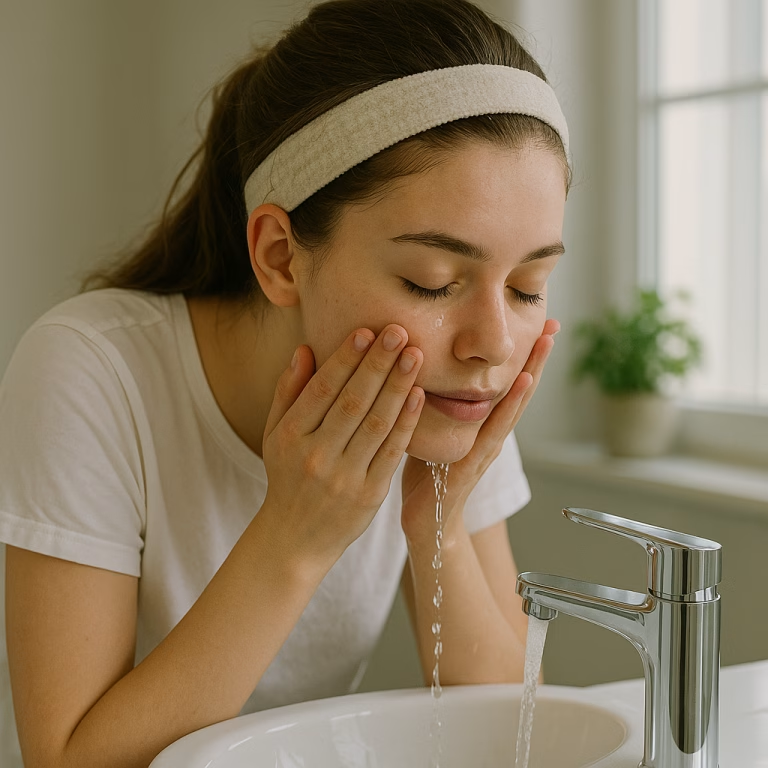
I. Introduction to Atopic Dermatitis 🌟
Atopic dermatitis, often called eczema, is a chronic inflammatory skin condition that leads to red, itchy, dry, and cracked skin. It’s a lifelong condition for many and can begin as early as infancy. In fact, studies show that up to 20% of children and about 10% of adults worldwide are affected by atopic dermatitis. 🧒👩
While it’s not contagious, atopic dermatitis can be very frustrating and emotionally draining. The intense itching can lead to scratching, which makes the skin even more damaged and sensitive, creating a cycle of flare-ups that is difficult to break without proper management.
✨ Why It’s Important to Understand Atopic Dermatitis
- Quality of Life Impact: Constant itching, pain, and skin appearance changes can affect self-esteem, relationships, work, and school performance.
- Risk of Infections: Damaged skin barriers make patients more prone to skin infections like staph bacteria.
- Emotional and Mental Health: People living with moderate to severe eczema often experience stress, anxiety, depression, and even sleep disturbances due to persistent symptoms.
✨ Who Is Most Affected?
- Infants and children are especially prone to developing atopic dermatitis. Many will “outgrow” it, but for others, it can persist into adulthood.
- Adults can also develop new cases of eczema later in life, sometimes triggered by allergies, asthma, or environmental factors.
- Family history of eczema, asthma, or hay fever (allergic rhinitis) increases the risk.
✨ How This Guide Will Help You
In this comprehensive guide, we’ll cover:
- The causes and risk factors that lead to atopic dermatitis 🔍
- The most common symptoms and how they evolve 📋
- How doctors diagnose the condition 🩺
- A detailed look at specialty treatments, including advanced options like ADBRY®, DUPIXENT®, CIBINQO®, and RINVOQ® 💉
- Lifestyle changes and home care tips that can help control flare-ups 🛁
- New research breakthroughs that offer hope for better treatments in the future 🔬
With the right information, support, and treatment plan, life with atopic dermatitis can absolutely get better. Let’s get started! 🌿
II. Understanding Atopic Dermatitis 🔍
Atopic dermatitis (AD) is more than just dry skin — it’s a chronic inflammatory condition that affects the skin’s ability to protect itself from irritants, allergens, and bacteria. It’s part of a group of allergic conditions known as the “atopic march,” which also includes asthma, food allergies, and hay fever (allergic rhinitis). 🌿
✨ What Exactly is Atopic Dermatitis?
At its core, atopic dermatitis happens because the skin’s natural barrier is weakened. When the skin barrier is compromised:
- Moisture escapes easily, leading to dryness and cracking.
- Irritants, allergens, and bacteria can enter the skin more easily, causing inflammation and infection.
- The immune system reacts strongly, making the skin red, swollen, and extremely itchy.
Atopic dermatitis is not contagious — you can’t catch it from another person. It’s a genetic and immune-related condition that usually has a strong family link.
✨ How Common Is It?
- About 1 in 5 children worldwide experience atopic dermatitis. 👶
- 10% of adults continue to suffer from it into their adult years or develop it later in life. 👩🦰
- It’s more common in people who live in urban areas and colder climates.
✨ Quick Facts About Atopic Dermatitis
- It often appears before age 5 and can persist into adulthood.
- Flare-ups can be triggered by certain foods, environmental allergens, weather changes, stress, and even sweating.
- People with atopic dermatitis are more likely to have other allergic conditions.
Atopic dermatitis is a complex condition, but with the right understanding and treatment approach, it can be controlled, and quality of life can dramatically improve! 🌟
III. Common Causes and Risk Factors ⚡
Atopic dermatitis doesn’t have just one single cause — it’s the result of a combination of genetic, environmental, and immune system factors. Understanding these can help you manage the condition better and reduce flare-ups. 🌿
✨ Main Causes of Atopic Dermatitis
- Genetic Mutations:
People with atopic dermatitis often have a mutation in the filaggrin gene. Filaggrin is a protein that helps build a strong, protective skin barrier. When it’s missing or defective, the skin loses moisture more easily and becomes more vulnerable to irritants and allergens. - Immune System Overreaction:
In people with eczema, the immune system overreacts to triggers, leading to chronic skin inflammation even when there’s no infection. - Skin Barrier Dysfunction:
The outermost layer of the skin (the epidermis) doesn’t work properly, allowing allergens, bacteria, and irritants to penetrate and cause inflammation.
✨ Major Risk Factors for Developing Atopic Dermatitis
- Family History:
Having a parent or sibling with eczema, asthma, or hay fever increases your risk. - Environmental Factors:
- Living in urban areas with high pollution 🌆
- Exposure to harsh soaps and detergents 🧼
- Cold, dry climates ❄️
- Contact with dust mites, pet dander, or pollen 🌸
- Allergies:
People with food allergies, allergic rhinitis, or asthma are more likely to have atopic dermatitis. - Stress:
Emotional stress doesn’t cause eczema but can worsen flare-ups. 🧠 - Skin Infections:
Bacterial, viral, or fungal infections can damage the skin further and trigger severe flare-ups. - Other Irritants:
- Wool or synthetic fabrics 🧥
- Cigarette smoke 🚬
- Excessive sweating 💦
- Long, hot showers 🚿
Understanding what triggers your eczema is a key part of preventing flares and keeping symptoms under control! 🛡️
IV. Symptoms of Atopic Dermatitis 📋
The symptoms of atopic dermatitis can vary a lot from person to person — and even for the same person, symptoms can change over time. Some people may only have mild irritation, while others experience severe, painful flare-ups that affect daily life. 🌿
✨ Common Symptoms of Atopic Dermatitis
- Dry, Sensitive Skin:
The skin feels rough, tight, and flaky. Moisture loss is one of the first signs. - Red or Brownish-Gray Patches:
These often appear on the hands, feet, ankles, wrists, neck, upper chest, eyelids, and inside the elbows and knees. - Itching (Pruritus):
Intense itching is a hallmark symptom. Scratching often worsens the condition and can lead to open sores or infections. 🔥 - Thickened, Cracked, or Scaly Skin:
Chronic scratching and inflammation cause the skin to thicken over time — a condition called lichenification. - Small, Raised Bumps:
These can leak fluid when scratched and then form crusts. - Raw, Sensitive, or Swollen Skin:
Especially noticeable during or after flare-ups. - Darkening Around the Eyes:
Sometimes called “allergic shiners,” these dark circles are common in people with severe atopic dermatitis.
✨ How Symptoms Vary by Age
- Infants:
- Rash often appears on the face and scalp.
- It may ooze fluid and crust over. 👶
- Children:
- Rashes commonly develop in the bends of elbows, behind the knees, wrists, ankles, and neck.
- Skin becomes thicker and scaly.
- Adults:
- Rashes can be widespread, especially on the face, hands, and neck.
- Skin may be very dry and easily irritated.
✨ Complications to Watch For
- Infections: Open wounds from scratching can lead to bacterial (like staph), viral (like herpes), or fungal infections.
- Asthma and Hay Fever: Many people with eczema later develop these conditions.
- Sleep Problems: Constant itching can cause poor sleep quality and daytime fatigue.
Recognizing these symptoms early can help you get the right treatment before the condition worsens! 🩺
V. Diagnosis of Atopic Dermatitis 🩺
Atopic dermatitis is usually diagnosed based on how your skin looks, your symptoms, and your personal and family history. There’s no single test to confirm eczema, so doctors rely heavily on a thorough evaluation. 🧠
✨ How Doctors Diagnose Atopic Dermatitis
- Clinical Examination:
A healthcare provider will carefully inspect your skin for common signs like redness, dryness, thickening, and location of rashes. - Detailed Medical History:
You’ll be asked about:- When your symptoms started
- How often flare-ups happen
- What triggers seem to make it worse (e.g., weather, soaps, stress)
- Family history of eczema, asthma, or allergies
- Symptom Pattern:
Atopic dermatitis typically follows a chronic (long-term) pattern with periods of flare-ups and remissions.
✨ Other Tests That May Be Used
- Allergy Testing:
If your doctor suspects that food allergies, pollen, pet dander, or other allergens are contributing, they may recommend skin prick tests or blood tests to identify specific allergens. 🌸🐶 - Patch Testing:
Helps rule out contact dermatitis, a different skin condition caused by direct irritation from a substance like nickel or fragrances. - Skin Biopsy (Rare Cases):
In unusual or severe cases, a small skin sample may be taken to rule out other conditions like psoriasis or skin infections.
✨ Differential Diagnosis: What Else Could It Be?
- Psoriasis: Thicker, silver-scaled plaques.
- Seborrheic Dermatitis: Greasy, yellowish patches, often on the scalp and face.
- Contact Dermatitis: Reaction to external irritants or allergens.
- Skin Infections: Sometimes mistaken for eczema if there’s redness and oozing.
Getting an accurate diagnosis ensures you get the right treatment plan tailored to your needs — not just symptom relief, but true skin healing! 🌿
VI. Specialty and Advanced Treatments for Atopic Dermatitis 💉
When basic skincare and over-the-counter treatments aren’t enough, many people with moderate-to-severe atopic dermatitis turn to advanced therapies. Thanks to medical breakthroughs, several specialty treatments are now available to help control inflammation, reduce itching, and prevent flare-ups more effectively than ever. 🌟
Here’s a look at the most important advanced treatment options:
🧬 Biologic Therapies
1. ADBRY® (tralokinumab)
- What it is:
A biologic therapy that specifically targets interleukin-13 (IL-13), a key driver of inflammation in atopic dermatitis. - How it works:
By blocking IL-13, ADBRY helps reduce inflammation, redness, and itching. - Usage:
Injectable medication, typically every two weeks. - Pros:
- Highly effective for moderate-to-severe eczema
- Well-tolerated in many patients
- Cons:
- Requires regular injections
- Possible side effects: injection site reactions, eye inflammation (conjunctivitis)
2. DUPIXENT® (dupilumab)
- What it is:
A biologic that blocks both interleukin-4 (IL-4) and interleukin-13 (IL-13) — two proteins involved in inflammation and allergic responses. - How it works:
Helps calm the immune system and repair the skin barrier. - Usage:
Self-injection every other week, after an initial loading dose. - Pros:
- FDA-approved for adults, teens, and children (as young as 6 months)
- Improves skin appearance and itch significantly
- Cons:
- Injection site reactions
- Risk of conjunctivitis or cold sores
⚡ Janus Kinase (JAK) Inhibitors
3. CIBINQO® (abrocitinib)
- What it is:
An oral medication that selectively inhibits JAK1, a key enzyme involved in the inflammatory response. - How it works:
Blocks signals that lead to eczema-related inflammation and itch. - Usage:
Taken once daily as a pill. - Pros:
- Rapid itch relief (often within days!)
- Oral option instead of injections
- Cons:
- May cause nausea, headaches, or increased risk of infections
- Requires careful monitoring for serious side effects (like blood clots)
4. RINVOQ® (upadacitinib)
- What it is:
Another oral JAK1 inhibitor, similar to CIBINQO but with slightly different dosing and side effect profiles. - How it works:
Reduces inflammation throughout the body by blocking JAK pathways. - Usage:
Taken once daily. - Pros:
- Fast and powerful relief for moderate-to-severe eczema
- Convenient oral tablet
- Cons:
- Risk of infections, heart problems, and blood clots (rare but serious risks)
- Requires routine monitoring (labs and checkups)
✨ Other Advanced Treatment Options
- Phototherapy:
- Narrowband UVB light therapy is used to reduce inflammation and itching without the need for daily medications.
- Topical Calcineurin Inhibitors:
- Medications like Tacrolimus (Protopic) and Pimecrolimus (Elidel) are non-steroidal creams ideal for sensitive areas like the face and neck.
- Systemic Immunosuppressants (Last Resort):
- Drugs like Cyclosporine and Methotrexate are used when biologics or JAK inhibitors are not effective.
🎯 Choosing the Right Treatment:
Your doctor will base your treatment plan on:
- Severity of your eczema
- Your age and overall health
- Previous treatment responses
- Personal preferences (injection vs. oral medication)
With so many new options available, many people are finally finding real, lasting relief from atopic dermatitis for the first time! 🌟
VII. Lifestyle and Home Management Strategies 🛁🌿
While advanced medications can make a huge difference, everyday lifestyle habits are just as important for managing atopic dermatitis. Good skin care and smart daily routines can help prevent flare-ups, reduce itching, and keep your skin healthier overall! 🌟
Here are the key strategies:
✨ Daily Skincare Routine
- Moisturize, Moisturize, Moisturize:
Apply a thick, fragrance-free moisturizer at least twice a day, especially after bathing. This locks in moisture and strengthens your skin barrier. 🧴 - Gentle Cleansing:
Use mild, soap-free cleansers that won’t strip the skin of its natural oils. - Short, Warm Showers:
Avoid long, hot showers that can dry out the skin. Keep baths or showers under 10 minutes using lukewarm water. 🚿
✨ Identifying and Avoiding Triggers
- Allergens:
Watch for dust mites, pet dander, pollen, and molds. Regularly clean your living space and use allergen-proof bedding. 🐶🌸 - Irritants:
Choose fragrance-free, dye-free soaps, shampoos, and detergents. - Clothing Choices:
Wear soft, breathable fabrics like cotton. Avoid scratchy materials like wool. - Temperature and Humidity:
Use a humidifier in dry weather and protect your skin from extreme cold or heat. ❄️☀️
✨ Stress Management
- Relaxation Techniques:
Stress is a known trigger for eczema flare-ups. Try deep breathing, yoga, meditation, or even journaling to help manage daily stress. 🧘♂️📖 - Adequate Sleep:
Good sleep hygiene helps your skin and immune system recover. Keep your sleeping environment cool and use soft bedding.
✨ Diet and Nutrition
- Anti-inflammatory Diet:
Foods rich in omega-3 fatty acids (like salmon, walnuts, and flaxseeds) may help reduce inflammation. 🐟🥑 - Watch for Food Sensitivities:
In some cases, foods like dairy, eggs, soy, or wheat can trigger eczema flare-ups. Work with your doctor before making major diet changes.
🎯 Consistency is Key:
Making small, sustainable changes every day will have a big impact over time. Combining lifestyle strategies with medical treatments leads to the best long-term control of atopic dermatitis! 🌿
VIII. Emerging Research and Future Therapies 🔬🚀
The future looks very promising for people living with atopic dermatitis! Thanks to ongoing research, new treatments and approaches are being developed that aim to target the root causes of the disease even more precisely — offering hope for better control, fewer side effects, and even potential long-term remission. 🌟
✨ New Biologic Therapies in Development
- Next-Generation Biologics:
Scientists are creating biologics that target other key molecules involved in eczema, like IL-31 and TSLP.
These therapies could help people who don’t fully respond to current biologics like DUPIXENT or ADBRY. - Combination Biologic Therapy:
Future treatments may involve using two or more biologics together to block multiple pathways of inflammation for even better control.
✨ Microbiome-Based Treatments
- Skin Bacteria Balance:
Researchers are studying ways to restore healthy bacteria on the skin, like using probiotic creams or sprays.
A healthy skin microbiome could reduce infections and inflammation naturally. 🧫 - Staphylococcus Aureus Control:
New strategies are being explored to specifically target and reduce harmful bacteria without wiping out the good ones.
✨ Personalized Medicine
- Genetic Profiling:
In the near future, doctors may be able to analyze your genes to predict which treatments will work best for you, leading to more customized and effective treatment plans. 🧬 - Biomarker Testing:
Blood tests or skin samples might be used to measure inflammation markers and adjust treatments accordingly — kind of like a “weather report” for your eczema.
✨ Innovations in JAK Inhibitors
- Topical JAK Inhibitors:
Researchers are developing JAK inhibitors in cream or ointment forms, offering the power of systemic therapy with fewer risks. - Safer Oral Options:
Newer oral JAK inhibitors are being designed to have fewer serious side effects while maintaining strong anti-inflammatory action.
🎯 The Bottom Line:
Research is moving fast, and more effective, safer options are on the horizon. In the next few years, managing atopic dermatitis could become even easier, more personalized, and more hopeful than ever. 🌿🚀
IX. When to See a Specialist 🩺✨
Managing mild atopic dermatitis at home is often possible, but sometimes the condition becomes too severe, persistent, or complicated to handle without expert help. Knowing when to see a dermatologist or specialist can make a big difference in getting your skin under control faster and more effectively! 🌿
✨ Signs You Should See a Specialist
- Persistent Symptoms:
If itching, redness, or rashes don’t improve after two to four weeks of home treatment. - Severe Flare-Ups:
If you experience widespread redness, bleeding, or crusting, or if your skin is painful and raw. - Signs of Infection:
- Yellowish crusts
- Pus-filled blisters
- Fever
(These may indicate a bacterial, viral, or fungal infection that needs urgent care.)
- Sleep Problems:
If itching and discomfort are causing major sleep disturbances and affecting your daily activities. - Emotional or Mental Health Impact:
When eczema leads to anxiety, depression, low self-esteem, or social withdrawal — it’s time to seek help. - Need for Advanced Treatment:
If topical creams aren’t enough, you may be a candidate for advanced options like biologics (DUPIXENT, ADBRY) or JAK inhibitors (CIBINQO, RINVOQ). 💉💊
✨ Types of Specialists Who Can Help
- Dermatologist:
A skin specialist who can offer diagnosis, advanced treatment options, and management plans. - Allergist/Immunologist:
Especially helpful if you have food allergies, asthma, or environmental allergies alongside eczema. - Mental Health Professional:
If atopic dermatitis is seriously affecting your emotional well-being, therapists or counselors can provide support strategies.
🎯 Don’t Wait Too Long:
Early intervention by a specialist can prevent complications, reduce the severity of flare-ups, and improve long-term outcomes. Seeking expert help is a sign of strength, not weakness! 🌟
X. Coping Strategies and Support Resources 💬🌈
Living with atopic dermatitis can be challenging — both physically and emotionally. Beyond medical treatment, having the right coping strategies and knowing where to find support can make a huge difference in your quality of life. 🌟
✨ Emotional and Mental Health Coping Tips
- Acknowledge Your Feelings:
It’s normal to feel frustrated, sad, or anxious about a chronic condition. Talking about it with someone you trust can help. - Practice Stress Management:
Stress can trigger or worsen eczema. Helpful techniques include:- Deep breathing exercises 🧘♂️
- Meditation and mindfulness
- Journaling thoughts and emotions 📓
- Gentle yoga or stretching
- Set Realistic Expectations:
Healing is a journey, not a straight path. Celebrate small improvements, and don’t be too hard on yourself during flare-ups. - Focus on What You Can Control:
You can’t eliminate eczema overnight, but you can control your skincare routine, your environment, and your mindset.
✨ Finding Support
- Online Communities and Forums:
Connect with others who understand your experience! Some active communities include:- National Eczema Association Support Groups 🌍
- Facebook Groups for Eczema Warriors 📱
- Reddit’s r/Eczema community
- In-Person Support Groups:
Many cities have local eczema support groups through hospitals or health organizations. - Mental Health Resources:
If eczema is affecting your mental health, consider speaking with a therapist or counselor experienced in chronic illness support. - Educational Resources:
Stay empowered by learning more:- National Eczema Association (NEA)
- American Academy of Dermatology (AAD)
🎯 Remember:
You are not alone! 🤝 Finding emotional support, sharing your journey, and staying informed can help you stay strong, positive, and empowered — even on tough days.
XI. Final Thoughts 🌟📝
Atopic dermatitis can feel overwhelming at times, but with the right combination of knowledge, treatments, and self-care strategies, it’s absolutely possible to live a full, active, and comfortable life. 💪🌿
✨ Key Takeaways
- Understand the Condition:
Recognizing that atopic dermatitis is more than just dry skin helps you approach it with the seriousness it deserves. - Personalized Treatment is Key:
From advanced biologics like ADBRY and DUPIXENT to oral options like CIBINQO and RINVOQ, today’s treatments are more targeted and effective than ever.
Work closely with your doctor to find the best option for your skin and lifestyle. - Daily Care Matters:
Skincare routines, lifestyle habits, and emotional well-being all play a huge role in keeping symptoms under control.
Small, daily actions add up to major improvements over time! 🌿 - Stay Hopeful:
With new therapies emerging and research progressing rapidly, the future for people with atopic dermatitis looks brighter than ever. 🚀 - You’re Not Alone:
Whether through online communities, local support groups, or mental health resources, help is always available. Never hesitate to reach out. 💬🤝
🎯 Final Reminder:
Managing atopic dermatitis is a journey — and you have the tools, resources, and strength to move forward with confidence. Keep learning, stay consistent, and don’t be afraid to ask for support when you need it.
Better skin days are ahead! 🌈✨












